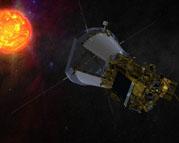Justin Kasper Selected as One of <i>Popular Science</i> Magazine's "Brilliant Ten" for 2011

Popular Science magazine has selected CfA astronomer Justin Kasper as one of this year's "Brilliant Ten" scientists. According to the magazine, the Brilliant Ten - all researchers under the age of 40 - represent the best of what science can achieve and demonstrate America's continuing cutting-edge research.
Kasper was recognized for his work designing and developing an instrument that will literally "touch" the Sun. When NASA's Solar Probe Plus launches before the end of the decade, it will carry the Solar Wind Electrons Alphas and Protons (SWEAP) Investigation - the first instruments ever to directly sample the Sun's outer atmosphere.
Two puzzles about the Sun continue to defy explanation more than half a century after their discovery. Why is the atmosphere of the Sun, or corona, thousands of times hotter than the surface of the Sun beneath it? And how is a fraction of the Sun's atmosphere accelerated to escape as the solar wind? The best way to understand what causes the observed heating and acceleration is to send a probe directly into the solar corona, and advances in technology and mission design have finally made this possible.
Solar Probe Plus will explore the Sun in a way no spacecraft has before, swooping through the solar corona to within four million miles of the solar surface. At closest approach, the Sun will appear more than 20 times wider and 500 times brighter than it does on Earth. The probe will have to withstand temperatures exceeding 2,550 degrees Fahrenheit. SWEAP includes an innovative instrument that will extend beyond the spacecraft's heat shield and directly sample the Sun's outer atmosphere
"Working on the first spacecraft to enter the atmosphere of the Sun is absolutely a dream come true. I'm grateful that NASA selected SWEAP for Solar Probe Plus, as our ability to collect samples of the atmosphere throughout each encounter with the Sun is a tremendous capability for the mission," said Kasper.
"Popular Science was my first magazine subscription and a big inspiration for my interest in the physical sciences. I'm honored to be selected by Popular Science for this recognition, and delighted by the opportunity to talk about the amazing teams working on SWEAP and Solar Probe Plus," he added.
Kasper is featured online at: http://www.popsci.com/science/article/2011-09/brilliant-10-sun-diver